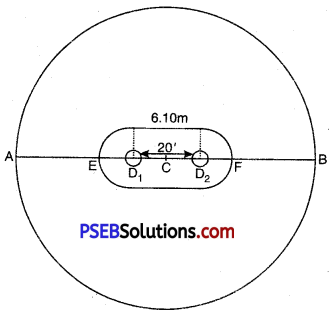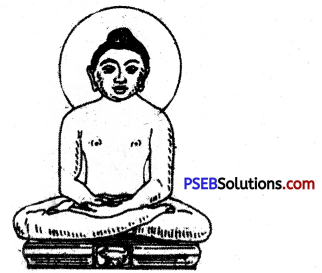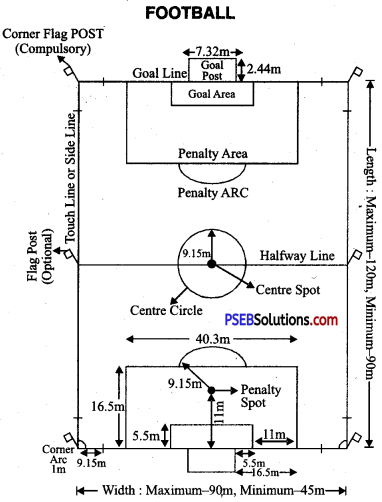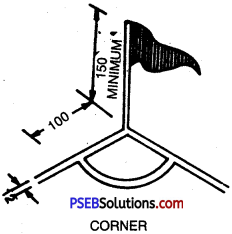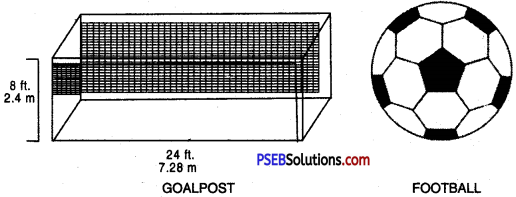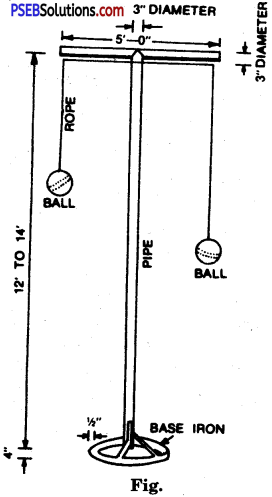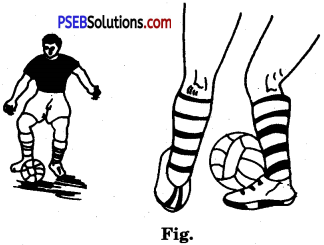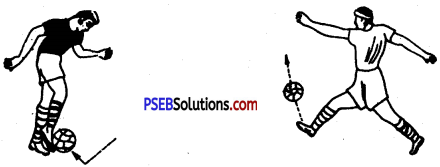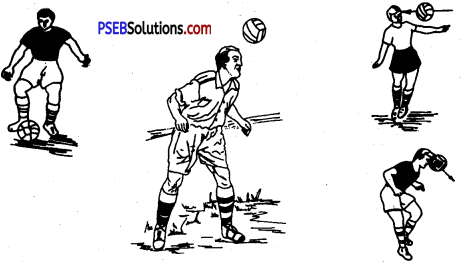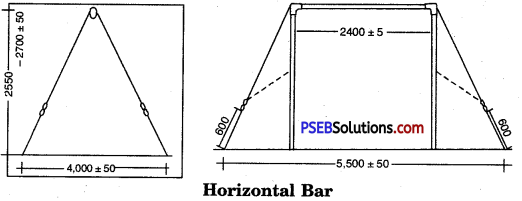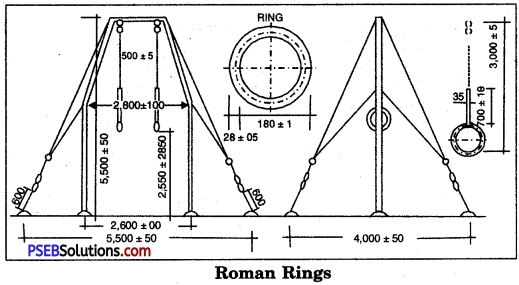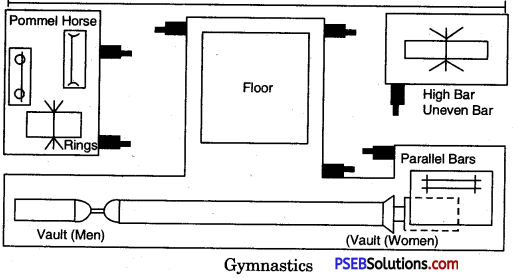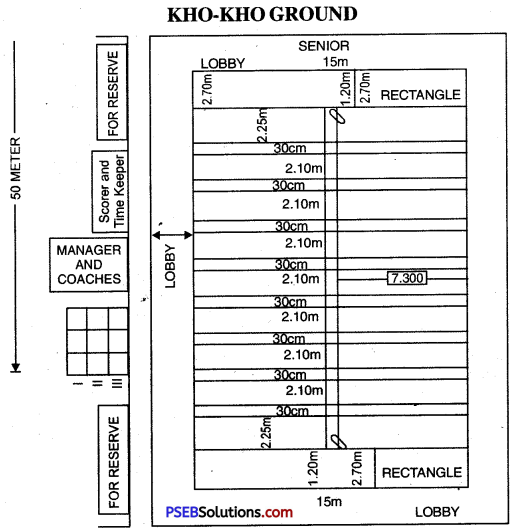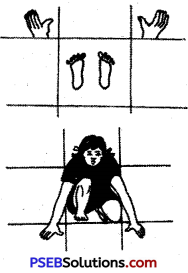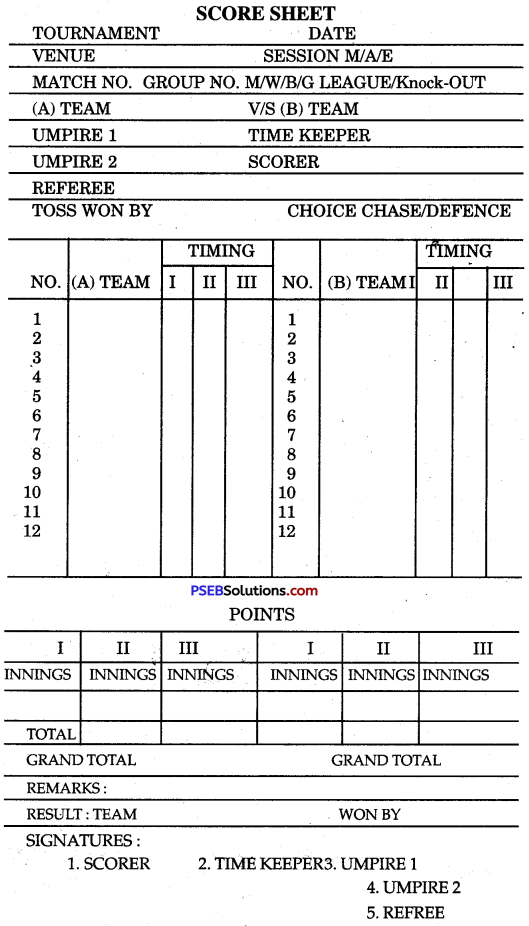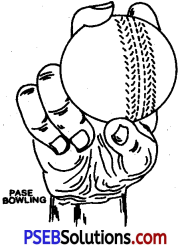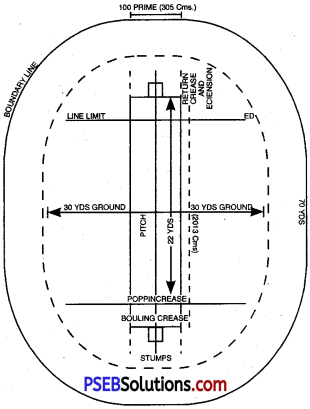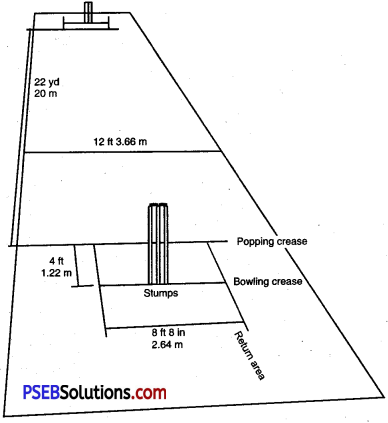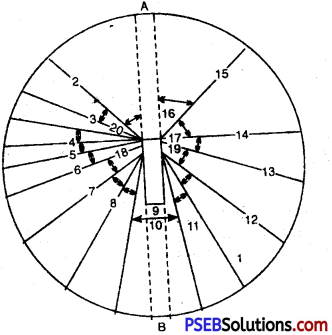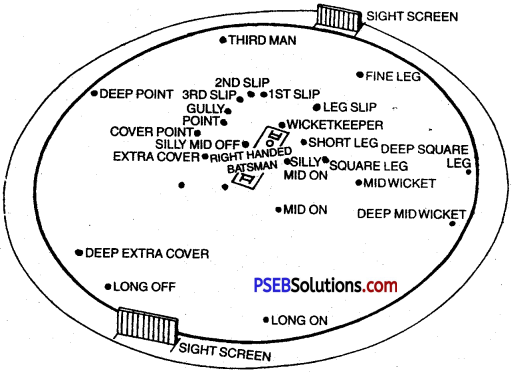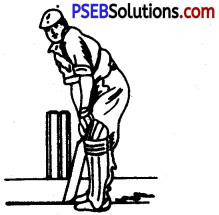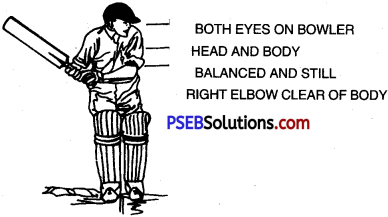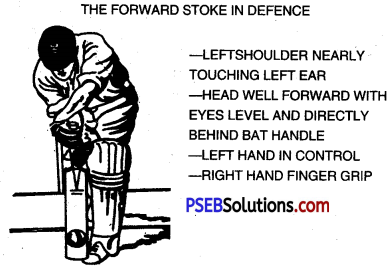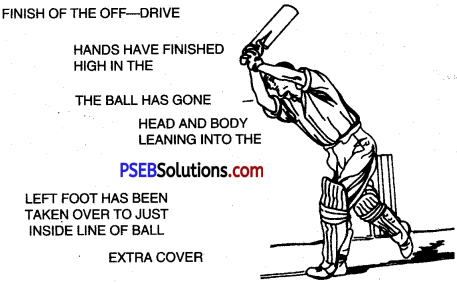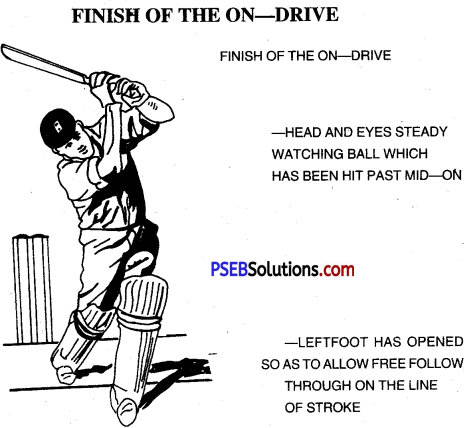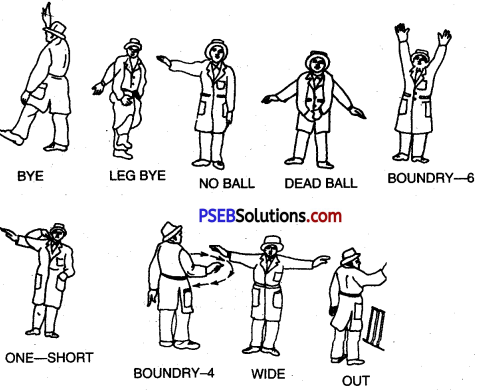Punjab State Board PSEB 10th Class Physical Education Book Solutions Basketball Game Rules.
Basketball Game Rules – PSEB 10th Class Physical Education
Question 1.
Describe the game of Basketball, its court and Restricted Area?
Answer:
The game of basketball is played between two teams. Each team consists of 5 players. The number of substitutes is 5-7. Each team aims at throwing the ball into the basket of the opposing team, and the opposing team tries to prevent the other team from securing the goal. The basketball court is 28 metres long and 15 metres broad. Its length and breadth can be decreased by 2 and 5 metres respectively in proportion to the two sides.
The height of the hall is 7 metres, and the light should be uniform. Its floor should be wooden or cemented: It can be made of synthetic rubber. For the competition of FIBA (International Amateur Basketball Federation) the court should be of specified dimensions. The boundary lines of the basketball court shall be marked at every point at least 2 metres away from any obstruction. The breadth of lines shall be 5 cms.
Board:
Backboards should be made of hard wood or of fibre glass. Each board should be 2 cm. thick. A rectangle behind the ring above the board of the dimension of 59 cms. horizontal and 45 cms. vertical is made with 5 cm. broad lines. The boundary of the board is also marked with 5 cm. broad lines. The lower edge of the board from the ground is 2.75 metre high.
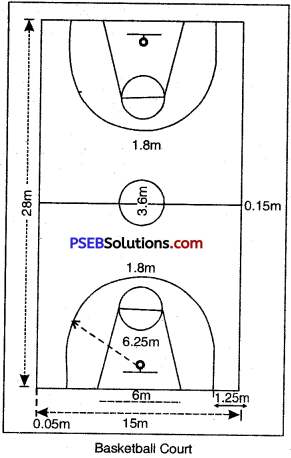
Basket:
The basket is made of white net with iron rings. The length of the net is 40 cm. and the radius of the ring is 45 cms. while its thickness is 20 mm.
Centre Line:
A centre line, parallel to the end lines, shall be marked. It shall divide the court into Front Court and Back Court. This line shall be 15 cm. outside on both sides.
Centre Circle:
A circle with a radius of 1.80 m. shall be marked exactly in the centre of the court. It shall be measured from the outer line of the circle.
Three Points Field Goal Area:
The three points field goal area is marked by two arcs, which is from a radius of 6.25 metres to the outer edges of the centre of the side line. It is directly perpendicular to the centre of the basket. The end lines are parallel to the side lines. The distance between the end line and the lines of the three point field goal area is 1.25 m. The centre point is 1.575 metre from the inside edge of the mid point of the end line. The arc is only upto semi-circle and is thereafter parallel to the side line.
Restricted Area, Free Throw Lines:
Parallel to each end line, a free throw line with its further edge at a distance of 5.80 m. shall be drawn. It shall be 3.60 m. long and its mid-point shall be on the line joining the mid points of the two ends.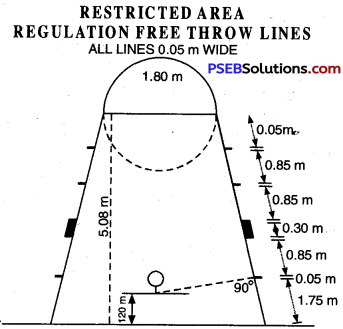
The restricted area is formed by the lines from end lines and free-throw lines. Its radius is marked by end lines and free-throw lines. The outer edge of these lines shall be 3 metres from the mid-points of end-lines and finish at the ends of the free throw lines. This line is in the semi-circle with a r idius of 1.80 m. in the court.
The first line is 1.75 m. from the inside edge of the end line. The first lane place shall be limited by a line 85 cm away. Next to it will be neutral zone 30 cm in width. The second lane place shall be 85 cm in width and is close to the neutral zone. The third lane place will be adjacent to the second lane place and shall be 85 cm in width. Each marked portion in the broken semi-circle shall be 35 cm. in length and the gap between two portions shall be 40 cm.

Backboard Size, Material and Position:
Backboards should be made of hard wood or of fibre glass. Each backboard is 3 cm. in thickness. It is 1.80 metre horizontally and 1.20 metre vertically. A 59 × 45 cm. rectangle is made behind the ring on the board. The width of its lines is 5 cm. The upper edge of this line is parallel to the level of the ring. The board is limited by 5 cm. thick lines. The lower edge of the board is 2.75 metre high from the ground. The uprights that support the backboards“shall be at a distance of 1 m. from the outer-edges of the end-lines in the restricted area.
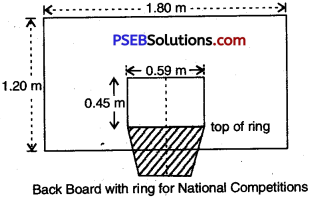
BASKET:
The basket is made of rings and net. It is 40 cm. in length. It is fixed with an iron ring. The rings are 45 cm. in inside diameters. The radius of this orange painted basket is 45 cm. The metal of rings is 20 mm. thick. A net made of white cord suspends from the rings. The rings are made in such a way that when the ball passes through it, they check it momentarily. The length of the net should be 40 cm.
Ball:
The ball is spherical. It is made of leather and has in it a rubber bladder. Its circumference is from 75 to 78 cm. Its weight is from 600 to 650 gms. The rules also now permit the use of used ball. The referee may choose a used ball. The ball should have been so much inflated that when it falls on the ground from a height of 1.80 m. it does not bounce from its upper edge, by not less than 1.20 m. and not more than 1.40 m.
A ball, once selected, cannot be used by any player before the match. A new ball may be used in case a suitable used ball is not available.
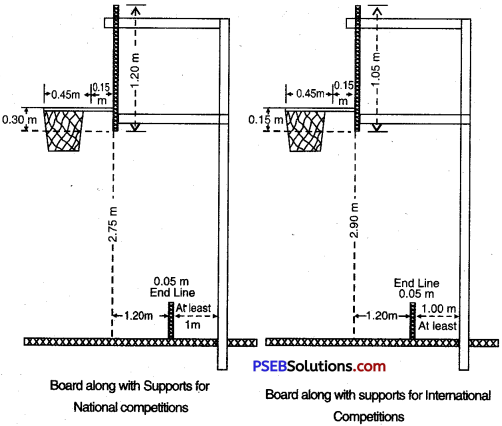

Question 2.
What type of technical equipment is used in the game of Basketball?
Answer:
Technical Equipment
(a) (i) Game Watch
(ii) Time-out Watch
(b) Score-sheet
(c) Marks numbered from 1 to 5 having a minimum size of 20 cm × 10 cm. Marks from 1-4 shall be black while mark 5 is red.
(d) An efficient instrument visible to players and spectators to implement the 30 second rule.
(e) A Score Board, visible to all, having game points (scores) of both the teams written on it.
(f) Scorers shall have two red flags as foul markers of both the teams. The flag will be brought to the side of the team in case of eight fouls during a certain period and will be visible to the players, coach and game officials.
Question 3.
What is the number of officials conducting the game of Basketball?
Answer:
Officials and their Assistants and their Duties
(i) Referee’s Duties:
- It is the referee’s duty to look after the whole equipment and to give advice to the players through signs
- To perform other functions according to rales.
- To make the scorer fill up the record sheet.
- To toss in the middle of the game
- To conduct the whole game under his care. He gives proper decisions to both the teams. His decisions are adhered to by all the players
- He also adjudicates in case of misunderstanding among players, and conducts the game according to rales
- If a player plays wrongly, he awards him penalty (8) He signs the score sheet at the end of the play and awards victory or defeat.

Time-Keeper:
(1) His function is to have control over time during the play. Before the start of the game he informs the referee that the game is to begin within three minutes so that he may inform the teams. After the interval he also reminds the referee that two minutes have left in the beginning of the game.
(2) He keeps the whole record from the start to the end of the game. He has to remember as to how long the game could not be played. When the time keeper rings the bell, the referee also blows his whistle to declare that time is over.
Scorer:
- His duty is to note the scores made by a player in the score sheet.
- He writes down the names of the all the players on the score sheet before the start of the game.
- The scorer should know as to how many scores have been made by an individual player.
- He adds each score made by a player very carefully to his account.
- He should note all the fouls done by a player on the side of his fouls. When a player makes five fouls, he informs the referee about it so that the player may be expelled from the game.
- After the end of the play, scorer gets the signature of the referee on the score sheet. Two scores are made if the ball falls from above in the basket. One score is made in case of a free throw.
Player Leaving Court:
No player can leave the court until the interval or until the rules permit without the permission of the game officials.
Captain:
Only the captain can talk to the officials for seeking any information or interpretation of any sort. The right to substitute a player lies with the coach or the captain acting as a coach.
Duration of Play:
The game is played in the four durations of 20 minutes each. There is an interval of 10 minutes for rest between the four durations.
Start of Play:
The referee starts the game. He shall toss the ball for a centre jump between two opponent players in centre circle. The game shall not start until five players of each team have entered the ground. If within five minutes after the starting time, a team does not enter the playground, the opposing team shall get walk over, that is, it is declared winner without playing.

Question 4.
What is the Jump ball in Basketball, what type of fouls can occur during Jump ball?
Answer:
Jump Ball. At the time of jump ball the two jumpers shall stand with their feet inside the half of the circle beside their respective basket, and one of their feet shall be beyond the centre of the line that is between them. An official shall toss the ball upward in such a way that no player can reach it by jumping and the ball drops between them.
No player shall tap the ball before it reaches its full height. A jumping player can tap the ball only twice. The moment the violation during the jump ball is made, it is penalised with a throw in at the side line. It is mid point for the opponents.
Goal:
A goal is scored when the ball enters the basket from above and is held there or passes through it. Two points are counted when a goal from the field is attempted from within the 3 point line, and one point when a goal is attempted from free throw. A field goal attempted from beyond the 3-point line would count 3 points.
Obstacle during Attack:
When the ball goes downward flight above the basket, no player shall touch or catch it even if an attempt is being made for goal.
Obstacle during Defence:
When an opponent tries for a goal by tossing the ball and the ball is above the level of the basket area and begins its downward flight, then no defender shall try to touch it. In case of violation, the ball shall become dead. If the violation occurs at the time of free throw, the thrower is awarded one point, and if it occurs at the time of attempting a goal, the thrower is awarded two points.
Ball in the Play after the Goal:
Five seconds after a goal has been secured, any player of the opposing team shall put the ball in play from any point out of bounce at the end of the court.
Decision of Play:
A team scoring greater number of points is declared the winner.
Forfeit of Play:
If any team does not enter the playfield after the interval or when the time is due on the call of the referee, the ball shall be brought in the ground and the absent team shall forfeit the game. If during the play the number of players of a‘team comes down to 2, the game shall come to end and that team forfeits the game.
Score and Extra Time:
In case the score is a tie at the end of the second half, five minutes more and such time more will be given till the decision of the game is given. In an extra period, there shall be tos? to select the basket, and thereafter in every extra period the basket shall be changed.
Time-out:
Each team can get two times-out until interval and one time out in one extra period. A time-out of one minute is given in case a player receives an injury. If during this time the injured player does not get well, a substitute is taken.

Question 5.
Describe five second, Eight second, three second and twenty four second rules?
Answer:
Five second Rule:
If a closely-guarded player blocks the ball from play and does not attempt to throw the ball in the game within five seconds, it is called blocking.
Eight second Rule:
When a team receives the ball in its back court, it has to send the ball into its front court within ten seconds.
Twenty four second Rule:
As per new rule, a new 24 second period does not begin following a throw in from out of line bounds at the side line until:
(a) The ball has gone out of bounds and throw-in is taken by a player from the same team.
(b) The officials have suspended the play to protect an injured player and the throw-in is taken by a player from the team to which the injured player belongs. After 30 seconds the operator will re-start the device from the time it was stopped when team control is again established by the same team after the thrown-in has been made.
Termination of Play:
On receiving the signal of the termination of play by the time keeper, the game shall be terminated.
Substitution of Player:
A substitute player before entering the court shall report to the scorer and shall be ready to play the game immediately. As soon as he gets the signal he shall reach the court. He should not take more than twenty seconds in reaching the court. If he takes more time, it shall be deemed as time-out, and it shall be charged against the opposing team.
Dead Ball:
The ball is dead when the ball, already in flight, on a shot for a goal, is touched by any player after time has expired for half or extra period or after a foul has.been called.
Three-second Rule:
When the ball is in the control of a team, no player of that team can remain for more than three seconds in the opponent court.
Dribbling:
Dribbling holds an important place in basketball. A player learns half of the game when a player has learnt to have full control over the ball and to dribble the ball. When a player continues to toss the ball into the air, fall it on the ground, and then re-takes it, it is called dribbling. When a player after having taken the ball places his foot on the floor in such a way that he appears to be rotating on a point, it is called pivot foot.
Ball in Play after Foul:
When a ball goes out of play by a foul, this dead ball shall be taken in play by
- a throw-in from out-of-bounds, or
- by a jump-ball at one of the circles, or
- by one or more free throws.
Throw-in:
A ball shall be known to be dead in case of violation of rules, and the opposite team is awarded a throw-in from a close point on side line. The rule now permits a player who is to make the throw-in to touch the end line, and it is no longer a violation now.
Free throw:
A player on whom the foul is made takes a free throw. But in a technical foul any player can take a free throw. When a free throw is attempted, the positions of other players shall be as follows:
- Two players of the opposing team shall stand near the basket.
- Other players shall take alternate positions.
- Other players can take any position provided they do not disturb a free-throw.
Violation of Free-throw Rules:
After the ball has been given to a player for a free throw:
(a) He must throw the ball within five seconds and in such a way that it enters the basket or touches the ring
(b) While the ball is on its way to the basket or is on or within the basket, no player shall touch it.
(c) The thrower shall not touch the floor or across the free throw line. No. player of either team shall touch the free-throw line or create an obstacle for the player taking free throw.
Game to be Forfeited. As per the new rule it is no more necessary for the referee to put the ball in play in a manner as if both the teams were on the floor ready to play and forfeit the game. Now, if after the call for play by the referee a team refuses to play, the team shall forfeit the game.
Ball Return to Back Court. As per the new rule, the ball is sent into team ‘A’s back court provided it is touched by a player of the team A only when team ‘A’ has control of the ball in front court. Accordingly, a touch by player of the team ‘A’, while the ball is in control of the team B in the team A’s front court, if made to go into the team A’s back court, is not considered as caused to go into back court.
Further, during a throw-in from mid-point, the official makes it certain that the player takes his position by having his one foot on either side of the extended centre line.
Violation on Out of Bounds Play:
It is not considered to be a violation when a player, who has been awarded a throw-in, steps on the line while releasing the ball.
Penalty:
(i) If the infringement is made by the free-thrower, no point shall be recorded. The ball shall be given out of bounds on the side line to the opponent.
(ii) In case there is an infringement by a team-mate of the free thrower, the point shall be recorded. If the violation is done by both the teams, no point shall be recorded and the play will be restarted with a jumping ball on the free-throw line.
(iii) In case of the violation of rule (c) by a team-mate of the free thrower and the free-throw is successful, the goal shall be counted ignoring the violation. In case the free-throw is not successful, it shall be penalised.
(iv) In case of the violation of rule (c) by the free thrower’s opponents and the success of the free throw, a goal shall be counted ignoring the violation.
(v) If the rule (c) is violated by both the teams and the free-throw succeeds, the goal shall be counted ignoring the violation. If the free-throw does not succeed, the play shall be resumed by a jump ball on the free- throw line.

Question 6.
How many types of fouls are there in the game of Basketball?
Answer:
Technical Foul by Player. No player shall ignore the warning given by the official, and behave in a manner which does not behove a good player, for example:
- Addressing an official in a disrespectful manner, or meeting him.
- To misbehave,
- Troubling an opponent or obstructing his vision by waving the hand before his eyes.
- Obstructing or delaying the game in an improper way.
- Not raising the arm properly on the signal of a foul.
- Changing his playing number without reporting to the scorer or referee.
- Sending the substitute in the court without reporting to the scorer.
Penalty:
Every offence shall be considered a foul and the opponents shall be awarded two free throws for one foul. For repeated offence of this rule, the player shall be disqualified and expelled from the game.
Technical Foul by Coach or Substitute Player:
No coach or a substitute player can enter the court without the permission of the official. He can neither leave his place to follow the action in the court nor address an opponent disrespectfully.
Penalty:
On the violation of this rule by the coach, a four shall be recorded against him. For each offence a free-throw shall be awarded and the ball shall be given to the same team for throw-in on the central line. On the repeated violation of this rule, the coach can be removed from the vicinity of the court.
Personal Foul:
The person who makes a personal foul blocks, attacks, catches or pushes an opponent carrying the ball normally. At such a moment the referee blows his whistle and awards penalty.
Penalty:
If a foul is committed on a player who is in the act of shooting, then
(i) if a goal is scored, it shall be counted, and one free-throw shall be awarded, (ii) if the shot for goal (2 points) does not succeed, two free- throws shall be awarded, and (iii) if the shot for goal (3 point attempt) remains unsuccessful, three free-throws shall be awarded.
Intentional Foul:
It is that personal foul which a player commits intentionally. A player who commits this foul time and again is disqualified and expelled from the play.
Penalty:
An offender shall be charged of personal foul, and two free-throws shall be awarded. If this foul is committed by a player who scores a goal, the goal shall be counted, and an extra free-throw shall be awarded.
Double Foul:
A double foul is committed in such a situation in which two opposing players strike against each other, and both of them are at fault. This foul is recorded against both the players. In case of this foul, the play is resumed from the near circle by a jump ball.
Multiple Foul:
A multiple foul is committed when two or more players of a team commit a personal foul on one opposing player. In case of such a situation, a foul shall be recorded against each offending player, and the player against whom it is committed shall be awarded a free-throw. If the foul has been committed against a player during the act of shooting, the goal, if made, shall be counted and one free-throw shall be awarded.
Five Fouls:
If a player commits five fouls, either personal or technical, he shall be turned out.
Three for two Rule:
When a player is about to score a goal and an opponent commits a foul, if the goal is scored, one more free-throw shall be given. In case no jfoal is scored and if neither of the two free-throw succeeds, an additional free-throw shall be awarded.
Right of Option:
The right of option for a throw-in from mid-point is applicable in respect of one and two throws and three free-throws. Before the option is made, the captain is permitted to have a Brief consultation with the coach.
Four Fouls by a Team:
After a team has committed four player fouls (personal or technical) in a half all subsequent players shall be penalised by two free throws. If a player’s foul includes two or three free-throws.
Jump Ball:
The game is played with jump-ball at the start of the game, after the interval or when double or multiple foul is committed. The referee tosses the ball between the opposing players inside the centre circle. Both the players try to catch the ball by jumping. The game starts with the touch of a player on the ball.
Fouls during Jump Ball:
During jump ball the player commits following types of fouls:
- Jumping at each other.
- Touching the line.
- Touching the ball in flight after it has been tossed by the referee.
- Elbowing or pushing the opponent during jumping in order to block the opponent’s jump.
- Blocking the opponent’s jump by placing one’s foot on the opponent’s foot during the process of jumping.
- Touching the lines of the radius during jumping.
- Moving of the players from one place to the other while jumping.

Question 7.
Describe the important passes in basketball?
Answer:
Important Passes In Basketball
1. Two Hands Chest Pass:
The pass is made quickly by placing the ball in front of the chest with both the hands. This pass is made when the player faces no opponent. It is given to the team mates by holding the ball in both the hands, raising shoulders and arms, bending the body a little and by pressing one foot forcibly. This is a normal practice in the game.
2. Side Arm Pass:
This pass is given to the team-mates by either extending or raising the arm. This way is put into practice when a player wants to give pass to his playmate who is away. This pass can be given when an obstruction occurs during the process of dribbling. Then a player gives pass to another by extending his arm. Some teams are very well- versed in putting the ball jnto the ring from the centre.
3. Over-head Pass:
This pass is given to the team-mates by raising both the arms. It is considered to be proper when a player is surrounded by many opponents. The player makes the pass by crossing the ball over many heads raising his arm. The opponents have to make very bard efforts to block such a ball given through this type of pass.
4. Ground Pass:
This pass is given when the opposing player is tall, and the ball cannot be crossed over his head. At that time, the pass is given by throwing the ball on the ground.
5. Back Pass:
This pass is given from Back Side. The player moves to by tossing the ball on the hands, and in case there is an obstruction on the way, he gives back pass to his team mate standing behind.
Important Information About the Basketball Game
- The length and breadth of court = 28 × 15 m
- Number of players in one team = 12, five players, seven substitutes.
- Radius of central circle = 1.80 meter
- Breadth of lines = 5 c.m.
- Thickness of the board = 3 c.m. c
- Height of the board from floor = 2.90 meter
- Dimension of board = 180 × 120 c.m.
- Circumference of the ball = 75 to 78 c.m.
- Weight of the ball = 600 to 650 gm
- Rectangle size of the board = 49 × 45 c.m.
- Distance of each pole = 2 meter
- Duration of the game = 10-2-10 (10) 10-2-10 from half
- Officials of the match = One table commissioner, One referee, One Umpire, One chief Refree, One time keeper, One scorer and 24 second operator.
- A match of basketball is played between two teams. Each team has 5 players, and 5 or 7 substitutes.
- The basketball court is rectangular. It is 28 metres long and 15 metres broad. The court must be made of wood or cement.
- Each member of the team shall be numbered from 4 to 15 on the front and back of his vest or shirt. The front numbers should be 6″ long and the back numbers 15″.
- The game has four durations of 10-2-10-10, 10-2-10. Until the interval which is of 10 minutes, no player can leave the court without the permission of the concerned official.
- During the play players can be substituted any number of times but their names must appear on the score sheet, and the substitution of player can take place at the throw or watch of the substituted team or at dead ball.
- Two or three free throws are awarded, as per the situation, after a foul which follows 4 fouls in one half of a team.
- A player is expelled from the match after he has done five fouls.
- The weight of the basketball is from 600 to 650 gms. and its circumference is from 75 to 78 cms.
- During the play of a game, a coach can secure a time out (which is of 1 minute) two times for rest.
- The radius of the centre circle of the basketball court is 1.80 m, the thickness of the board is 3 cm, the height of the lower edge of blackboard from the ground is 2.75 m, the height of the ring is 3.05 m and the length of the white net is 40 cms. The breadth of all boundary lines is 5 cms.
![]()
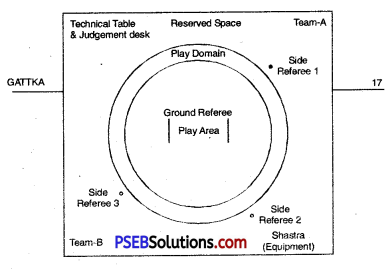

![]()
![]()
